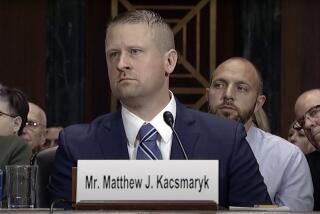What’s in the teen pregnancy pact’s fine print?
- Share via
Today’s question: Is the so-called Gloucester teen-pregnancy pact an anomaly, an indication of something wrong with modern parenting or something else? Kerry Howley and Kay Hymowitz debate the politics of children. Later this week, they’ll discuss juvenile obesity, fertility rates and other topics.
Fathers ignored
Point: Kay Hymowitz
Kerry, you’ve probably heard that teen pregnancy has been on the decline. Rates of childbearing by girls in their teens plunged by a third between 1991 and 2005, an extraordinary drop that took experts by surprise. That doesn’t mean they didn’t try to take credit for the good news; comprehensive sex educators congratulated themselves on the growing use of condoms at first intercourse by teens, and abstinence proponents cheered the fact that kids were having less sex. My own view is that sex educators are not as important as they think they are. In reality, their curricula simply reflect the reigning cultural consensus, which in the late 1980s and early ‘90s, because of record high crime rates and welfare rolls, turned sharply against teen motherhood.
So how do we explain the Gloucester pregnancy pact, the agreement by a group of 15- and 16-year-olds at a Massachusetts high school to get pregnant and raise their children together? It could be just a bunch of bored kids doing something so mind-boggling -- think Columbine -- that people feel a need to read meaning into it that it really doesn’t have.
But I’m inclined to suspect that the Gloucester story is more than a media feast. In fact, there are signs that the strong anti-teen pregnancy cultural consensus I referred to earlier is fraying. For one thing, teen pregnancy numbers ticked up between 2005 and 2006 for the first time in 14 years. Suddenly, popular culture is getting into the teen mommy business. When Nickelodeon star Jamie Lynn Spears got pregnant, there was some booing, but much of the coverage was pretty sympathetic. And not to go all Dan Quayle on you, but the (in my mind, misguided) enthusiasm for the movie “Juno,” an unrealistic portrait of a savvy teen mother-to-be, might also reflect a changing zeitgeist.
Actually, no one should be surprised at this. When teen pregnancy rates declined, childbearing by single women in their early 20s was on the increase. It makes sense that teenagers would wonder: My older sister has a baby, and she’s no genius; why not me? They may even have evidence on their side. According to Frank Furstenberg’s extensive longitudinal study of teen mothers, the children of disadvantaged adolescent moms don’t look much different than the children of disadvantaged mothers in their 20s.
In fact, teen pregnancy was always an opportunistic framing by public health officials of the more sensitive problem of family breakdown. In the 1980s, experts warned of an “epidemic” of teen births. The truth is teen births were no higher than they had been in the 1950s. What had changed was that the teenagers in question no longer felt the need to be married to their kids’ fathers. Experts may have been right that teens are too young to raise children in our complex economy, but boy, were they wrong when they decided to ignore fathers!
Kay Hymowitz is a senior fellow at the Manhattan Institute and contributing editor of City Journal. Her most recent book is “Marriage and Caste in America: Separate and Unequal Families in a Post Marital Age.”
Hopeless? Try motherhood!
Counterpoint: Kerry Howley
Kay,
I think it’s quite premature to declare a new cultural consensus regarding teen pregnancy. As you mentioned, birth rates for women age 15 to 19 dropped sharply between 1991 and 2005 -- from a rate of 61.8 per 1,000 to 40.5 per 1,000. Yes, the birth rate ticked up a year after -- to 41.9, about the same rate as in 2002. (In 2002, those same rates were considered a triumph.) A little noise in the data and another unfunny Judd Apatow movie are not reasons to dismiss an unambiguous long-term trend.
Although I’m not convinced that we’re about to see a rash of tween obstetric covenants sweep the nation, the Gloucester story squares with much of what we know about the motivations driving young single motherhood. In their study of single low-income (though not exclusively teen) mothers in Philadelphia, “Promises I Can Keep,” Kathryn Edin and Maria Kefalas find that many such women conceive of motherhood as the most important social role they will ever play, “the surest source of accomplishment within reach.” For women with limited opportunity and constrained ambition, motherhood confers meaning and some measure of prestige. Discussing the Gloucester pact with NPR, Kathleen Kingsbury, a Time magazine reporter, said the girls “decided if they needed an identity, being a mother would be their identity.” And as a classmate of the pact clique put it, “no one’s offered them a better option.”
High teen pregnancy rates in the U.S. are a straightforward response to limited educational options and the pervasive romanticization of motherhood. If we send girls to inadequate public schools while trumpeting the incomparable glories of the mother-child bond, they’re going to seek status where they can. Nor did the baby-bump-obsessed editors at InTouch magazine come up with the idea that child-care is a woman’s highest calling; this is a central tenet of the traditionalist creed that also happens to sell magazines.
None of which is to say that the Gloucester teens are representative of trends in teen pregnancy. For one thing, they’re younger; the vast majority of teen mothers are 18 or 19, while none of these girls had reached 17. We don’t know the particular socioeconomic status of each pactee, but Gloucester is largely white and middle-income. Teen mothers are disproportionately black and Latino and tend to come from low-income families.
I can’t get into the head of a 16-year old who brightens up when she hears she is about to spend 9 months with a tiny human in her uterus, but a passing familiarity with the data should indicate the teen pregnancy is something one aspires to when few other opportunities abound. As you rightly suggest, the answer to this is not yet another health class demonstration involving Trojans and bananas. It’s the much more difficult task of persuading young women to hope for something bigger and better.
Kerry Howley is a senior editor at Reason magazine.
Day 1 | | | |
More to Read
A cure for the common opinion
Get thought-provoking perspectives with our weekly newsletter.
You may occasionally receive promotional content from the Los Angeles Times.










